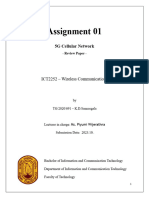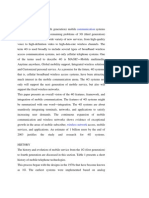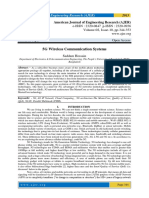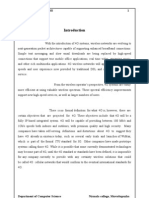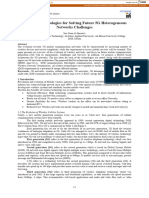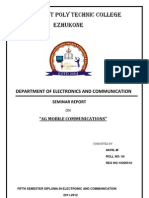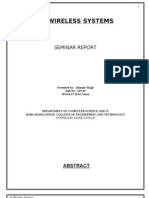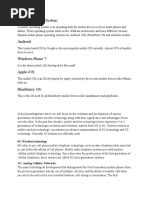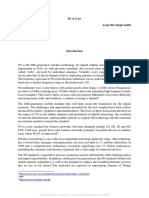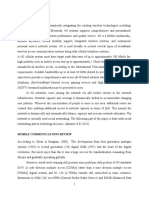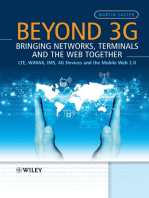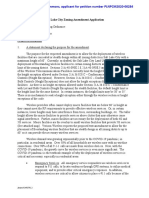5G Network A New Look Into The Future: Beyond All Generation Networks
5G Network A New Look Into The Future: Beyond All Generation Networks
Uploaded by
Alex KhanCopyright:
Available Formats
5G Network A New Look Into The Future: Beyond All Generation Networks
5G Network A New Look Into The Future: Beyond All Generation Networks
Uploaded by
Alex KhanOriginal Title
Copyright
Available Formats
Share this document
Did you find this document useful?
Is this content inappropriate?
Copyright:
Available Formats
5G Network A New Look Into The Future: Beyond All Generation Networks
5G Network A New Look Into The Future: Beyond All Generation Networks
Uploaded by
Alex KhanCopyright:
Available Formats
American Journal of Systems and Software, 2014, Vol. 2, No.
4, 108-112
Available online at http://pubs.sciepub.com/ajss/2/4/5
Science and Education Publishing
DOI:10.12691/ajss-2-4-5
5G Network a New Look into the Future: Beyond all
Generation Networks
Sidhartha Sankar Sahoo*, Malaya Kumar Hota, Kalyan Kumar Barik
Department of Electronics and Telecommunication Engineering, Synergy Institute of Engineering & Technology, Dhenkanal 759001,
Odisha, India
*
Corresponding author: sidhartha.nmiet@gmail.com
Received June 08, 2014; Revised August 04, 2014; Accepted August 20, 2014
Abstract Were still in the middle of the 4G revolution, in that the superfast mobile data service is still in its
infancy in both coverage and speed capabilities. Customers of telecommunication demand more and more from their
technology. To maintain such a powerful system, we require a high speed wireless connectivity. The drawbacks of
4G mobile technology led the researchers and developers to arise with more advanced and efficient technologies. 5G
mobile technology is the next generation of wireless networks that will totally replace existing 4G networks. This
paper focuses on all preceding generations of mobile communication along with fifth generation technology. Fifth
generation network provides reasonable broadband wireless connectivity (very seamless high speed). The paper
throws light on the difference from 1G to 5G.
Keywords: 1G, 2G, 3G, 4G, 5G, 5G architecture
Cite This Article: Sidhartha Sankar Sahoo, Malaya Kumar Hota, and Kalyan Kumar Barik, 5G Network a
New Look into the Future: Beyond all Generation Networks. American Journal of Systems and Software, vol. 2,
no. 4 (2014): 108-112. doi: 10.12691/ajss-2-4-5.
1. Introduction
Wireless technologies are going to take new dimension
in our lives. The wireless broadband will soon become
readily available to everybody while, being at home,
driving the car, sitting in the park, and even on a pleasure
boat in the middle of a lake. And because of this, our need
to have information at anytime and to be connected at all
places, all the time, will be satisfied. The world of
universal,
uninterrupted access to information,
entertainment and communication will open new
dimension to [1] our lives and change our life style
significantly. In this way 5G is the new evolution of this
new era. 5G is the name currently being given to the next
generation of mobile data connectivity that will come after
the last drop has been wringed from 4G. It will provide
unbelievably fast broadband speeds, but more importantly
it will have enough capacity wherever you go to perform
every function you want it to without a drop in speed or
connection, no matter how many people are connected at
the same time.
generation, 4G - the fourth generation, and then the 5G the fifth second generation as shown in Figure 1.
Figure 1. Evolution of mobile generation
2. Evolution
Mobile communication has become more popular in
last few years due to fast revolution in mobile technology.
This revolution is due to very high increase in mobile
customers [2]. This revolution is from 1G - the first
generation, 2G- the second generation, 3G - the third
Figure 2. Moores law
American Journal of Systems and Software
Moores law: Moores Law is stated as: the number
of transistors that can be fit onto a square inch of silicon
doubles every 12 months. Moores law describes a longterm trend in the history of computing hardware but it also
prove true for wireless technologies. From 1G to 4G
wireless bit rate has increased from 2.4 Kbps to 100 Mpbs.
The statement of Moores Law is shown in Figure 2.
Similarly considering to the no. of transistors, Moores
Law can be shown in terms of use of bits per seconds (bps)
and no. of users as shown in Figure 3 and Figure 4
respectively.
109
The second generation, 2G system, fielded in the late
1980s and finished in the late 1990s, was planned mainly
for voice transmission with digital signal and the speeds
up to 64kbps. GSM and CDMA IS 95 were prominent
technologies. It uses digital signals for voice transmission
and has speed of 64 kbps. It provides facility of SMS
(Short Message Service) and use the bandwidth of 30 to
200 KHz [2,3].
2.2.1. (2.5G)
2.5G is used to describe 2G-systems that have
implemented a packet switched domain in addition to the
circuit switched domain. 2.5 G can provide data rate, up to
144 kbps. GPRS, EDGE and CDMA 2000 were 2.5
technologies [3].
2.3. Third Generation (3G)
Figure 3. Use of bps over year
The third generation, 3G wireless system, was
developed in the late 1990s and might be well-done in the
late 2000s. 3G is not only provided the transmission
speeds from 125 kbps to 2 Mbps, but also included many
services, such as global roaming, superior voice quality
and data always add-on. UMTS, CDMA, EVDO, HSPA
are 3G technologies. In 3G the data are sent through
Packet Switching technology and Voice calls are
interpreted through Circuit Switching technology. Along
with verbal communication it includes internet services,
access to television/video streaming, GPS (Global
Positioning System) and new services like Global
Roaming. It operates at a range of 2100 MHz and has a
bandwidth of 15-20 MHz used for High-speed internet
service, video chatting [3].
2.4. Fourth Generation (4G)
Figure 4. No. of user over year
2.1. First Generation (1G)
The
first
generation,
1G
wireless
mobile
communication systems, was introduced in the early
1980s and completed in the early 1990s. 1G was analog
and supported the first generation of analog cell phones
with the speeds up to 2.4 kbps. The prominent ones
among 1G system were advanced mobile phone system
(AMPS), Nordic mobile telephone (NMT), and total
access communication system (TACS). It uses analog
radio signal which have frequency 150 MHz, voice call
modulation is done using a technique called FrequencyDivision Multiple Access (FDMA). It has low capacity,
unreliable handoff, poor voice links, and no security at all
since voice calls were played back in radio towers, making
these calls susceptible to unwanted eavesdropping by third
parties [2,3].
2.2. Second Generation (2G)
The fourth generation (4G) is a conceptual framework
for high speed wireless network that can transmit
multimedia and data to and interface with wire-line
backbone network perfectly. The speeds of 4G can
theoretically be promised up to 1 Gbps. LTE is considered
as 4G technology. 4G offers a downloading speed of
100Mbps. 4G provides same feature as 3G and additional
services like Multi-Media Newspapers, to watch T.V
programs with more clarity and send Data much faster
than previous generations [3,4]. 4G is being developed to
accommodate the QOS and rate requirements set by
forthcoming applications like wireless broadband access,
Multimedia Messaging Service (MMS), video chat,
mobile TV, HDTV content, Digital Video Broadcasting
(DVB), minimal services like voice and data, and other
services that utilize bandwidth.
4G networks are integrated with one core network and
several radio access networks. A core interface is used for
communication with the core network and radio access
networks, and a collection of radio interfaces is used for
communication with the radio access networks and mobile
users. This kind of integration combines multiple radio
access interfaces into a single network to provide seamless
roaming/ handoff and the best connected services.
The main distinguishing factor between 3G and 4G is
the data rates. 4G can support at least 100 Mbps peak rates
in full-mobility wide area coverage and 1 Gbps in lowmobility local area coverage. The speeds of 3G can be up
to 2 Mbps, which is much lower than the speeds of 4G.
110
American Journal of Systems and Software
However, 4G standard will base on broadband IP-based
entirely applying packet switching method of transmission
with seamlessly access convergence. It means that 4G
integrated all access technologies, services and
applications can unlimitedly be run through wireless
backbone over wire-line backbone using IP address. But
5G will be the new entrance for real world wireless or
called WWW: World Wide Wireless Web.
2.5. Fifth Generation (5G)
This generation is expected to be rolled out around
2020. 5G network technology will open a new era in
mobile communication technology. The 5G mobile
phones will have access to different wireless technologies
at the same time and the terminal should be able to
combine different flows from different technologies. 5G is
predicted to be an intelligent technology capable of
interconnecting the entire world without limits.
At present, 5G is not a term officially used for any
particular specification or in any official document yet
made public by telecommunication companies or
standardization bodies likes Wi-Max Forum or ITU-R.
New release will further enhance system performance and
add new capabilities with new application areas [5,6,7].
5G would be the next major phase of mobile
telecommunications standards beyond the 4G/IMTAdvanced standards. The 5G technologies include all type
of advanced features which make 5G mobile technology
most powerful and in huge demand in near future. Users
can hook their 5G technology cell phones with their
Laptop to get broadband internet access. Some of the
applications, benefiting from mobile connectivity are
home automation, emergency response, intelligent
shopping smart transportation sustainable urban
environment, smart product management security and ebooks. The details Synopsis of evolution are shown in
Table 1.
Table 1. Synopsis of evolution
Generation
Features
1G
2G
3G
4G
5G
Deployment
1970 1980
1990 - 2001
2001-2010
2011
2015-20 onwards
Data Rates
2kbps
14.4-64kbps
2Mbps
200 Mbps to 1
Gbps
1Gbps and higher
Digital Cellular Technology:
Digital narrow band
circuit data
Packet data
Digital Broadband
Packet data:
CDMA 2000
EVDO
UMTS
EDGE
Digital
Broadband
Packet data:
WiMax LTE
Wi-Fi
wwww Unified IP
seamless
combination of
broadband
LAN
PAN
MAN
WLAN
Enhanced
audio, video
streaming
IP telephony
HD mobile TV
Dynamic
Information
access,
Wearable devices
with AI
Capabilities
CDMA
CDMA
Technology
Analog Cellular
Technology
Service
Analog voice
service
No data service
Digital voice with higher clarity
SMS, MMS
Higher capacity packetized data
Enhanced audio video
streaming
video conferencing
support
Web browsing at
higher speeds
IPTV support
Multiplexing
Switching
FDMA
TDMA, CDMA
CDMA
Core Network
PSTN
PSTN
Packet N/W
Internet
Internet
2G:GSM
2.5:GPRS
2.75:EDGE
IMT-2000
3.5G-HSDPA
3.75G:HSUPA
Single unified
standard
LTE,
WiMAX
Single unified
standard
www
www(IPv4)
www (IPv4)
wwww (IPv6)
Standards
MTS
AMTS
IMTS
WEB Standard
Handoff
Horizontal only
Horizontal only
Horizontal & Vertical
Horizontal &
Vertical
Horizontal &
Vertical
Shortfalls
Low capacity,
Unreliable handoff,
Poor voice links, Less
secure
Digital signals were reliant on
location & proximity, required
strong digital signals to help
mobile phones
Need to accommodate
higher network
capacity
Being deployed
Yet to be
implemented
3. Key Concepts of 5G and beyond 4G
Wireless Communications [5,6,7]
a. Massive Dense Networks also known as Massive
Distributed MIMO providing green flexible small cells 5G
Green Dense Small Cells. A transmission point equipped
with a very large number of antennas that simultaneously
serve multiple users. With massive MIMO multiple
messages for several terminals can be transmitted on the
same time-frequency resource, maximizing beam forming
gain while minimizing interference.
b. Advanced interference and mobility management,
achieved with the cooperation of different transmission
points with overlapped coverage, and encompassing the
option of a flexible usage of resources for uplink and
downlink transmission in each cell, the option of direct
device-to-device transmission and advanced interference
cancellation techniques.
c. Efficient support of machine-type devices to enable
the Internet of Things with potentially higher numbers of
American Journal of Systems and Software
connected devices, as well as novel applications such as
mission critical control or traffic safety, requiring reduced
latency and enhanced reliability.
d. Pervasive networks providing Internet of things,
wireless sensor networks and ubiquitous computing: The
user can simultaneously be connected to several wireless
access technologies and seamlessly move between them.
These access technologies can be 2.5G, 3G, 4G, or 5G
mobile networks, Wi-Fi, WPAN, or any other future
access technology. In 5G, the concept may be further
developed into multiple concurrent data transfer paths.
e. Multi-hop networks: A major issue in beyond 4G
systems is to make the high bit rates available in a larger
portion of the cell, especially to users in an exposed
position in between several base stations. In current
research, this issue is addressed by cellular repeaters and
macro-diversity techniques, also known as group
cooperative relay, where also users could be potential
cooperative nodes thanks to the use of direct device todevice (D2D) communications.
f. Wearable devices with AI capabilities such as smart
watches and optical head-mounted displays for augmented
reality.
g. Li-Fi (a portmanteau of light and Wi-Fi) is a massive
MIMO visible light communication network to advance
5G. Li-Fi uses light-emitting diodes to transmit data,
rather than radio waves like Wi-Fi.
4. 5G architecture
Up to 4G, the wireless evaluation is following path of
Moores law. The newer generations were identified by
increased bit rate. (2G (9.6 Kpbs) to 4G (1Gbps)). There is
belief that, 5G will be generation will defy the Moore law
and it will be phase of integration of network technologies,
rather expansion or evaluation of new wireless standard.
The architectural diagram is shown in Figure 5.
111
4.1.2. EDGE (Exchanged Data Rate for GSM
Evolution)
It is an advanced version of GPRS.
It provides a data speed of 473kb/sec.
4.1.3. 3G
3G makes it possible to do video call on mobile
network.
It also provides efficient way to browse internet on
mobile network.
4.1.4. WLAN (Wireless Local Area Network)
WLAN provides short range, high speed wireless
data connection between mobile data device using
radio signal.
4.1.5. LTE (Long Term Evolution)
LTE is a standard for mobile communication for high
speed data transmission for mobile network.
It has speed up to 100mbps.
4.2. Technologies of 5G
The technologies behind 5G architecture are [5,6]
a. NanoEquipment
b. Cloud computing
c. IP platform
4.2.1. NanoEquipment
In 5G mobile equipment is generally reffered as nano
equipment. This mobile is designed by nano core
technology which has ubiquitous specification as given
below
Self cleaning: The mobile cleans by itself
Self charged: the mobile derives its power from sun,
water or air.
Flexible: not breakable
Environmental sensor: The mobile gives details
about weather, temperature, pollutiion.
4.2.2. Cloud Computing
Cloud computing is a technology that uses the internet
and central remote server to maintain data and
applications. Cloud computing allows consumers and
business to use applications without installation and
access their personal files at any computer with internet
access. The development of cloud computing provides
operators with tremendous opportunities. Since cloud
computing relies on the networks, it shows the
significance of networks and promotes network
development.
4.2.3. IP Platform
Figure 5. Architectural diagram of 5G
4.1. Services
The services behind 5G architecture are
4.1.1. GPRS (General Packet Radio Service)
It is used to transmit data at 60kb/sec.
It also consumes less battery during sending and
receiving mail or to browse internet.
IP architecture acts as an essential part of 5G network.
The IP Network is an evolution of the 4G system to meet
the increasing demands of the mobile telecommunications
market. IP provides a continued evolution and
optimization of the system concept in order to provide a
competitive edge in terms of both performance and cost.
The key benefits of flat IP architectures are:
lower costs
universal seamless access
112
American Journal of Systems and Software
improved user experience
reduced system latency
decoupled radio access and core network evolution
5. Objectives of 5 G
5.1. Superior Service Quality and User
Experience
Consumer expectations for mobile broadband service
quality are growing in parallel with traffic complexity and
increase usage. Complex and constantly evolving multivendor networks and services are placing considerable
demands on service management. The focus shifting
towards managing the delivery of high-quality services i.e.,
support service centric and user-centric management [5,6].
5.2. Reliable Connectivity Experience
The next wave of the Digital Society will be
characterized by an ICT networks capability for
immediate service availability and on-demand adaptability.
An instant immediacy in mobile services will lay the
foundation for a whole new set of mobile apps to
proliferate and push the capabilities of communications
beyond what is currently possible. Widespread adoption of
M2M services will be encouraged when there would be
provision of higher network capacity required for handling
enormous connections [5,6].
6. Conclusion
At the present time Mobile equipments are designed
with higher processing power, more inbuilt and supporting
memory, longer battery life, more screen resolution and
more camera power for the same applications. The 5G
includes most recent technologies such as SDR, nano
technology, cognitive Radio, cloud computing and based
on all IP platforms. Finally 5G will bring evaluation of
active infra sharing and managed services and eventually
all existing network operators will be MVNOs (Mobile
Virtual Network Operators). We hope that this Paper helps
to promote stronger links between people working in
different fields creating future concepts of mobile
communication, Internet services, Cloud computing, All
IP network, and Nanotechnologies.
References
[1]
[2]
[3]
[4]
5.3. Ability to Handle Upsetting Growth in
Network Capacity
Server workloads are growing by 10% a year. Network
bandwidth demand is growing by 35%. Storage capacity is
growing by 50%. Power costs growth is 20%. Throwing
more capacity at demand is not the solution; there is a
need to optimize capacity in new ways. Over 1.5 billion
Web pages are accessible, 450,000 iPhone apps are being
accessed, over 200,000 Android apps are being used, and
10,500 radio stations are existing [5,6].
[5]
[6]
[7]
Nascimento, Andrea, et al. "A characterization of mobility
management in user-centric networks", Smart Spaces and Next
Generation Wired/Wireless Networking. Springer Berlin
Heidelberg, pg. 314-325, 2013.
Mohd. Maroof Siddiqui Vision of 5G Communication, A.
Mantri et al. (Eds.): HPAGC 2011, CCIS 169, Springer-Verlag
Berlin Heidelberg, pp. 252-256, 2011.
Akhilesh Kumar Pachauri, Ompal Singh, 5G Technology
Redefining wireless Communication in upcoming years,
International Journal of Computer Science and Management
Research Vol 1 Issue 1 Aug 2012.
Arun Agarwal, and Kabita Agarwal, The Next Generation Mobile
Wireless Cellular Networks 4G and Beyond. American Journal
of Electrical and Electronic Engineering, vol. 2, no. 3 (2014): 9297.
David Ott, Shilpa Talwar, Intel Labs, University Research Office,
Exploring Next Generation Wireless (5G): Transforming the user
Experience, 2013.
Suvarna Patil, Vipin Patil,.Pallavi Bhat, A Review on 5G
Technology, International Journal of Engineering and Innovative
Technology, Volume 1, Issue 1, January 2012.
Reshma S. Sapakal, Sonali S. adam, 5G Mobile Technology,
International Journal of Advanced Research in Computer
Engineering & Technology (IJARCET) Volume 2, Issue 2,
February 2013.
You might also like
- 5G Radio Network Planning GuideDocument87 pages5G Radio Network Planning GuideRey B.Salvo78% (9)
- 4g Asir PRRH QGDocument14 pages4g Asir PRRH QGRy GiNo ratings yet
- Network Slicing 5g Beyond NetworksDocument153 pagesNetwork Slicing 5g Beyond Networksshreyansh100% (7)
- CH 10 Mobile Technology and Its ApplicationsDocument30 pagesCH 10 Mobile Technology and Its ApplicationsMuhammad AyanNo ratings yet
- 4G Mobile Communication SystemDocument21 pages4G Mobile Communication SystemMohan GargNo ratings yet
- 4GMOBILESDocument11 pages4GMOBILESapi-26871643100% (1)
- Assignment 01: 5G Cellular NetworkDocument21 pagesAssignment 01: 5G Cellular NetworkKavindu DilharaNo ratings yet
- 5G Literature ReviewDocument11 pages5G Literature ReviewAaron RodriguesNo ratings yet
- 4G FeaturesDocument5 pages4G FeaturesRanjith KumarNo ratings yet
- Comparison of Mobile TechnologiesDocument8 pagesComparison of Mobile TechnologiesAbid Jan100% (1)
- 4g Mobile Communication System A Seminar Report (1) Computer Science Seminar TopicsDocument7 pages4g Mobile Communication System A Seminar Report (1) Computer Science Seminar TopicsfinitehourabyssNo ratings yet
- Seminar Report On 4G TechnologyDocument14 pagesSeminar Report On 4G TechnologyVářuŋ AħújåNo ratings yet
- 5g TechnologyDocument8 pages5g Technologysaisiddhartha606No ratings yet
- Seminar On 4G TechnologiesDocument24 pagesSeminar On 4G TechnologiesSelva RajNo ratings yet
- 4 4g Wireless Systems OrgDocument31 pages4 4g Wireless Systems OrgrbakoliaNo ratings yet
- A Future Communication Technology: 5G: 0G 1G 2G 3G 4G 5GDocument8 pagesA Future Communication Technology: 5G: 0G 1G 2G 3G 4G 5GMuhammad Arslan AshrafNo ratings yet
- PP Lab 5g TecDocument36 pagesPP Lab 5g TecOppo Y 15No ratings yet
- 4G Wireless Systems: Yuben JosephDocument8 pages4G Wireless Systems: Yuben JosephHashmi EugineNo ratings yet
- A Study On Third Generation Mobile Technology (3G) and Comparison Among All Generations of Mobile CommunicationDocument7 pagesA Study On Third Generation Mobile Technology (3G) and Comparison Among All Generations of Mobile Communicationc_subhasisNo ratings yet
- 4G and 5G OS Kenneth MadububaDocument24 pages4G and 5G OS Kenneth MadububaEgbezor Nnamdi HenryNo ratings yet
- Millimeter Wave Mobile Communication For 5G CellularDocument24 pagesMillimeter Wave Mobile Communication For 5G CellularVipinkumar HariharanNo ratings yet
- A Survey of 5G Network: Architecture and Emerging TechnologiesDocument27 pagesA Survey of 5G Network: Architecture and Emerging TechnologiesDijar VrellaNo ratings yet
- TopicDocument28 pagesTopicrohitNo ratings yet
- 4g - Mobile CommunicationDocument11 pages4g - Mobile CommunicationsrinivascbitNo ratings yet
- 4G BroadbandDocument39 pages4G Broadbandpraveenpv7No ratings yet
- 4G Technology: Team: Commwarrior Leela VatiDocument9 pages4G Technology: Team: Commwarrior Leela VatimalonanNo ratings yet
- Evolution of Mobile Technologies From 1G To 5G and The Future of Mobile CommunicationDocument13 pagesEvolution of Mobile Technologies From 1G To 5G and The Future of Mobile CommunicationdashasaiunNo ratings yet
- 5g PDFDocument10 pages5g PDFChaudhry Asad IqbalNo ratings yet
- Evolution of Mobile Technologies From 1G To 5G and The Future of Mobile CommunicationDocument13 pagesEvolution of Mobile Technologies From 1G To 5G and The Future of Mobile CommunicationdashasaiunNo ratings yet
- 4G Wireless Systems 1Document27 pages4G Wireless Systems 1Vineeth MathewNo ratings yet
- 5G Heterogenous NetworkDocument9 pages5G Heterogenous NetworkBhumika PiplaniNo ratings yet
- 5G Wireless Technology Seminar ReportDocument27 pages5G Wireless Technology Seminar Reportprashantkumar2806No ratings yet
- 5 Geneartion of Wireless Network: Keywords: Long Term Evolution, Nanocore, Flat IPDocument5 pages5 Geneartion of Wireless Network: Keywords: Long Term Evolution, Nanocore, Flat IPMunish KumarNo ratings yet
- Millimeter Wave Mobile Communications For 5G CellularDocument15 pagesMillimeter Wave Mobile Communications For 5G CellularFrancesco GrassiNo ratings yet
- CSE 5G Technology Report PDFDocument42 pagesCSE 5G Technology Report PDFSamarth SnehNo ratings yet
- Computer Fundamentals and Program Techniques: Victoria University of BangladeshDocument4 pagesComputer Fundamentals and Program Techniques: Victoria University of BangladeshcseijiNo ratings yet
- A Report On 4gDocument28 pagesA Report On 4gPallavi ChaturvediNo ratings yet
- 4G TechnologyDocument26 pages4G TechnologytheshlagNo ratings yet
- 425-Article Text-959-1-10-20210802Document3 pages425-Article Text-959-1-10-20210802dhananjeyanr.eceNo ratings yet
- 4G Communication Seminar ReportDocument29 pages4G Communication Seminar ReportAkhil Madhu100% (2)
- 4G Wireless TechnologyDocument22 pages4G Wireless TechnologyAnil KumarNo ratings yet
- Tran Et Al 5G Overview 171003Document26 pagesTran Et Al 5G Overview 171003Alaa DawoodNo ratings yet
- 4G Technologies: Jishnu.S, Iii-Cse, Hindusthan Institute of TechnologyDocument12 pages4G Technologies: Jishnu.S, Iii-Cse, Hindusthan Institute of TechnologyJishnu NairNo ratings yet
- Wireless Evolution With 4G Technologies: Prof. D. U. Adokar, Priti J. RajputDocument11 pagesWireless Evolution With 4G Technologies: Prof. D. U. Adokar, Priti J. RajputNebiye SolomonNo ratings yet
- Abstract On 5gDocument7 pagesAbstract On 5gGaurav Mishra100% (2)
- 4G-Beyond 3G and Wireless Networks: Indira Gandhi National Open University (IGNOU), Delh, IndiaDocument8 pages4G-Beyond 3G and Wireless Networks: Indira Gandhi National Open University (IGNOU), Delh, IndiaChara SukaNo ratings yet
- Cellular Networking Technology GenerationsDocument11 pagesCellular Networking Technology Generationsj17-10022-2021No ratings yet
- Seminar Report On 5 Pen PC TechnologyDocument23 pagesSeminar Report On 5 Pen PC TechnologyBiswajit Mohanty0% (2)
- 4g Wireless SystemsDocument29 pages4g Wireless SystemsGajendra ShankhwarNo ratings yet
- Mobile Operating System:: 0G Wireless TechnologyDocument3 pagesMobile Operating System:: 0G Wireless TechnologyhameedNo ratings yet
- SSRN Id3535484 PDFDocument72 pagesSSRN Id3535484 PDFzaid Al ZoubiNo ratings yet
- 5G Wireless Technology: Akshita Singhal Department of ECE Global College of TechnologyDocument3 pages5G Wireless Technology: Akshita Singhal Department of ECE Global College of TechnologychhabraashishNo ratings yet
- 2.1.2 Understand Evolution of Mobile Communication Systems - 1G, 2G, 2.5G, 3G and 4GDocument3 pages2.1.2 Understand Evolution of Mobile Communication Systems - 1G, 2G, 2.5G, 3G and 4GAbhishek AbhiNo ratings yet
- Current Trends and Future of 4G Technologies - 4G TechnologyDocument9 pagesCurrent Trends and Future of 4G Technologies - 4G Technologydummy12345No ratings yet
- Latest SeminarDocument29 pagesLatest Seminarmd_2829No ratings yet
- Bimbo SeminarDocument19 pagesBimbo Seminargolden abidemNo ratings yet
- Mobile Multimedia CommunicationDocument24 pagesMobile Multimedia CommunicationVikas KadamNo ratings yet
- 4g Wireless TechnologyDocument6 pages4g Wireless TechnologybindupuppyNo ratings yet
- Beyond 3G - Bringing Networks, Terminals and the Web Together: LTE, WiMAX, IMS, 4G Devices and the Mobile Web 2.0From EverandBeyond 3G - Bringing Networks, Terminals and the Web Together: LTE, WiMAX, IMS, 4G Devices and the Mobile Web 2.0No ratings yet
- The 5G Revolution: How the Next Generation of Wireless Will Change EverythingFrom EverandThe 5G Revolution: How the Next Generation of Wireless Will Change EverythingNo ratings yet
- Cellular Technologies for Emerging Markets: 2G, 3G and BeyondFrom EverandCellular Technologies for Emerging Markets: 2G, 3G and BeyondNo ratings yet
- 5G Network & IoT - Research Paper Final (21MCA2599, 21MCA2601)Document2 pages5G Network & IoT - Research Paper Final (21MCA2599, 21MCA2601)NehaNo ratings yet
- Ict Link TreeDocument3 pagesIct Link TreeRyoNo ratings yet
- Yello Trader November 2023Document23 pagesYello Trader November 2023Peter WitbooiNo ratings yet
- A PRACH Preamble Generation and DetectioDocument8 pagesA PRACH Preamble Generation and DetectioKashif VirkNo ratings yet
- Salt Lake City Zoning Amendment ApplicationDocument15 pagesSalt Lake City Zoning Amendment ApplicationAlyssa RobertsNo ratings yet
- 03.FI - 5G Training MaterialDocument19 pages03.FI - 5G Training MaterialSydney DodooNo ratings yet
- 2238 2785 1 SMDocument10 pages2238 2785 1 SMWilson IriarteNo ratings yet
- Ecm6450 Final ProjectDocument9 pagesEcm6450 Final Projectsaneric2019No ratings yet
- Cost Current Coverage Capacity Four C's of LPWA : Standards-Based AdvantagesDocument1 pageCost Current Coverage Capacity Four C's of LPWA : Standards-Based Advantagesrene_brookeNo ratings yet
- Nokia Global Network Traffic Report EnDocument23 pagesNokia Global Network Traffic Report Enamit aroraNo ratings yet
- Kathrein Street Connect: An In-Ground Antenna SolutionDocument26 pagesKathrein Street Connect: An In-Ground Antenna Solutioncyo3fffNo ratings yet
- History of Mobile CommunicationDocument25 pagesHistory of Mobile Communicationnenz187100% (1)
- ManojguptaDocument5 pagesManojguptajhalak.sNo ratings yet
- Scientist 5g Appeal FinalDocument11 pagesScientist 5g Appeal FinalthemoorNo ratings yet
- NR Physical Basic and Channel by Amit Kumar Goyal (6237001147)Document52 pagesNR Physical Basic and Channel by Amit Kumar Goyal (6237001147)Chua TCNo ratings yet
- Bandwidth, Throughput, Latency & Jitter in Mobile Networks: @3g4gUKDocument21 pagesBandwidth, Throughput, Latency & Jitter in Mobile Networks: @3g4gUKPhyo Kyaw SwarNo ratings yet
- Device-to-Device Communication in Cellular Networks: A SurveyDocument22 pagesDevice-to-Device Communication in Cellular Networks: A SurveymkawserNo ratings yet
- Pre-Compliance-Testing-Facility HaryanaDocument49 pagesPre-Compliance-Testing-Facility HaryanaManohar TmNo ratings yet
- SCF 253 5G Mmwave Small CellsDocument60 pagesSCF 253 5G Mmwave Small CellsRodrigo BarretoNo ratings yet
- Nokia Change Management Zakaria - Hichem - MS - IAIDocument23 pagesNokia Change Management Zakaria - Hichem - MS - IAIHichem TaouafNo ratings yet
- 2-ACP SSB Coverage Optimization (Based DT) - 202203Document29 pages2-ACP SSB Coverage Optimization (Based DT) - 202203Emerson Eduardo RodriguesNo ratings yet
- JVD 5g Xhaul SR 01 02Document16 pagesJVD 5g Xhaul SR 01 02SmahjoobNo ratings yet
- Feature Difference FDDVSTDD SAvsNSA FR1vsFR2 EngDocument21 pagesFeature Difference FDDVSTDD SAvsNSA FR1vsFR2 EngVVLNo ratings yet
- Asus Zenfone 8 - Full Phone SpecificationsDocument2 pagesAsus Zenfone 8 - Full Phone SpecificationsRally CautiverioNo ratings yet
- ICTICT501 SlideshowDocument61 pagesICTICT501 Slideshowyazdan kundiNo ratings yet
- 5G Technology: Danish Amin & MD ShahidDocument25 pages5G Technology: Danish Amin & MD ShahidRam PadhiNo ratings yet






